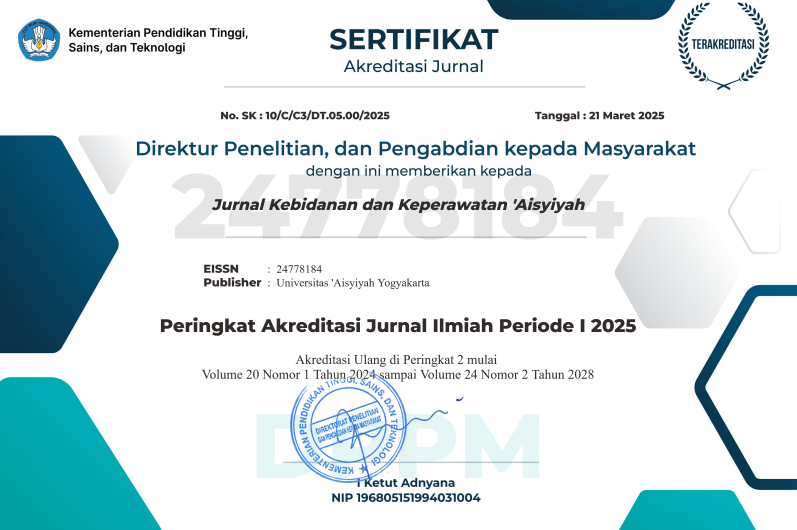Faktor-faktor resiko kejadian asfiksia pada bayi baru lahir
DOI:
https://doi.org/10.31101/jkk.291Abstract views 1507 times
Keywords:
asphyxia, neonatal risk factorsAbstract
Downloads
References
Biarge, M. M., Sebastian, J. D., Wusthoff,
C. J., Mercuri, L., Cowan, F. M. 2013. Antepartum and Intrapartum Factors. Preceding Neonatal Hypoxic-Ischemic En- cephalopathy.
Depkes RI. 2011. Manajemen Asfiksia Bayi Baru Lahir untuk Bidan, Jakarta: Dirjen Binkesmas Depkes.
Dinkes Bantul. 2014. Profil Dinas Kese- hatan Bantul. Bantul
Gilang, Notoadmodjo, H & Rachmawati,
M.D. 2011. Faktor - faktor yang Berhubungan dengan Kejadian Asfiksia Neonatorum (Studi di RSUD Tugurejo Semarang).
Kennedy, B.B., Ruth, D.J. & Martin, E.J. 2013. Modul Manajemen Intra- partum. Jakarta: EGC.
Konishi, M. N., Miyake, H., & Suzuki, S. 2012. Trial Of Labour After Ce- sarean Delivery as an Indevendent Risk Factor For Intrapartum Asphyxia in Sengleton Deliveries beyond 37 Weeks Gestation. Journal of Nippon Med Sch, 2012;79.
Kiyani, A. N., Khusdil, A& Ehsan, A. 2014. Perinatal Factors Leading to Birth Asphyxia among Term Newborn in a Tertiary Care Hospital. Iran Journal of Pediatrics. Oct 2014. Vol 24 (No.5, Pp: 637-642.
Lee, A.C., Darmstadt, G.L. & Luke C, M., 2008. Rick Factors For neonatal mortality due to birth asphyxia in southern Nepal. Pediatrics, 121, pp.1381–1390.
Manuaba. 2013. Ilmu Kebidanan Pe- nyakit Kandungan, dan KB. Jakarta: EGC.
Oswyni, G., Vince, J. D & Friesen, H. 2002. PerinatalAsphyxia at Port Moresby General Hospital: A Study Of Incidence Risk Factor and Out- come PNG Med Journal, 43 (1-
: 110-120.RS PKU Muhammadiyah Bantul. 2014. Medical Record RS PKU Muhammadiyah Bantul. Bantul.
SDKI. 2012. Survei Demografi Kese- hatan Indonesia.
Sofian, A., 2013. Rustam Mochtar Sinop- sis Obstetri/ : Obstetri Fisiologi, Obstetri Patologi. Jakarta: Pener- bit Buku Kedokteran EGC.
Swarjana, K. 2013. Metodologi Penelitian Kesehatan. Yogyakarta: Andi Offset.
WHO. 2006. Geneva Switzerland: Depar- tement of Reproductive Health and Research (RHR) and Department of Making Pregnancy Safer (MPS). Report of a WHO Technical Consultation on Birth Spacing.
Downloads
Additional Files
Published
How to Cite
Issue
Section
License
With the receipt of the article by the Jurnal Kebidanan dan Keperawatan Aisyiyah Editorial Board and the decision to be published, then the copyright regarding the article will be diverted to Jurnal Kebidanan dan Keperawatan Aisyiyah. Universitas 'Aisyiyah Yogyakarta as the publisher of Jurnal Kebidanan dan Keperawatan Aisyiyah hold the copyright regarding all the published articles in this journal.
Jurnal Kebidanan dan Keperawatan Aisyiyah is licensed under a Creative Commons Attribution-ShareAlike 4.0 International License.
















